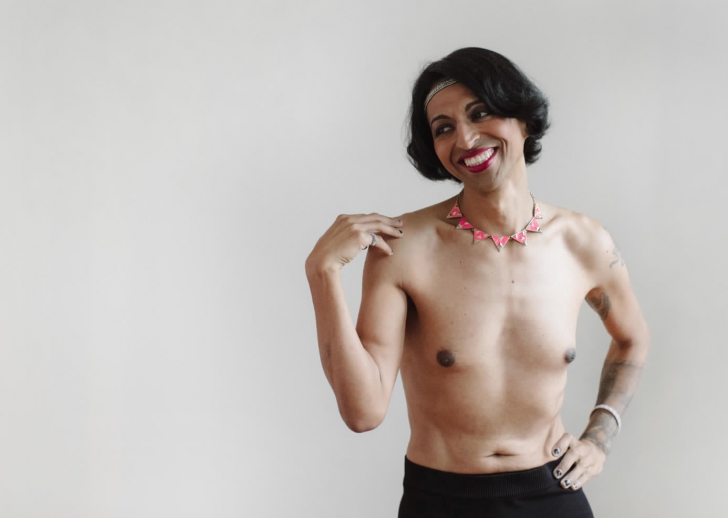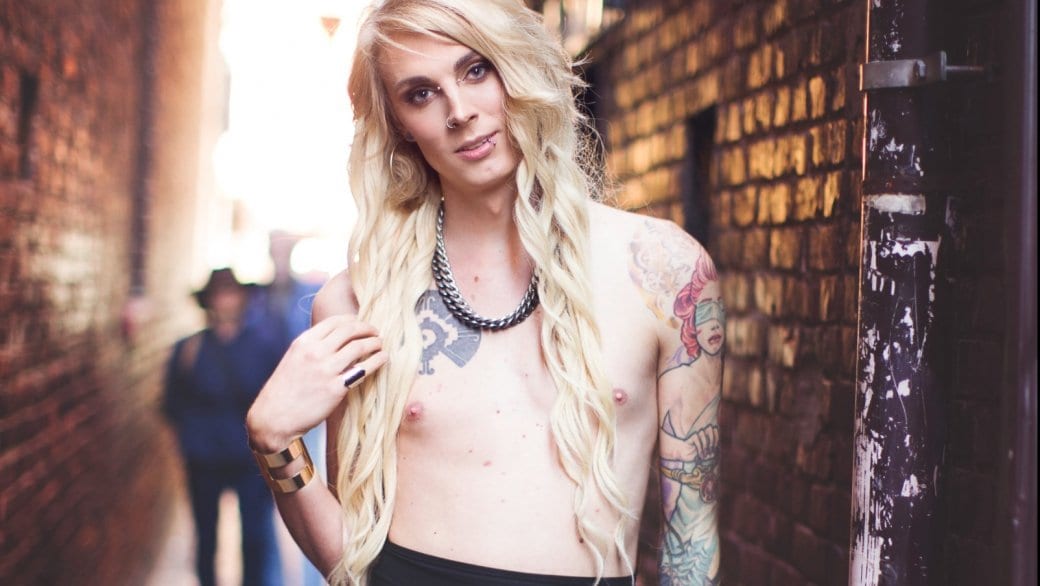When Courtney Demone posted topless photos of herself on Facebook and Instagram in September 2015, she wasn’t sure what the reaction would be. While depictions of women’s bodies are often a battleground on social media, as a trans woman at the beginning of her transition, it was hard to predict when her bare chest would be censored.
So using the hashtag #doIhaveboobsnow, Demone embarked on an experiment, posting photos of herself as she transitioned — and making note of when social media platforms chose to block or delete her posts.
If Carolina Brown’s experience is any indication, the answer is simple: “Eight months and two days.”
“I had no breast tissue whatsoever yet. I had nipples, but not something where you could tell that that’s a female’s breasts,” the trans Latina singer-songwriter says.
Brown started hormone replacement therapy in April 2015. Her pictures were flagged as inappropriate four months later. In December — eight months and two days after starting hormone therapy — her Facebook profile was suspended.

(Carolina Brown’s nipples were soon censored after she posed for the art project This Body Project./Scarlet O’Neill photo)
The alleged offence: a photo she took for This Body Project, an exhibit that ironically focuses on how women’s bodies are shamed.
Demone says her photos have received mixed responses since she began posting them. Some people appreciate the chance to chart the evolution of privilege lost; the more Demone presents as female, the more resistance her photos seem to encounter. Some responses are downright hostile. “A lot of dudes on Instagram say things like, ‘I’ll make you a woman, just give me a night,’” she says.
This type of hostile response, paired with society’s persistent ogling of women’s bodies in general, leaves many women, trans or not, feeling like they should just keep their shirts on in public.
Amber Grant, a queer woman in Toronto, says she has gone topless in public only once, at a Dyke March two years ago. While she felt comfortable at first, she says she felt increasingly vulnerable as she began to receive unwanted attention.
Some spectators approached her and took photos without her consent, she recalls. “I started calling them out and saying they had to ask permission. It got to the point where I ended up putting my shirt back on.”
To Paul Rapoport, a founding member of the Topfree Equal Rights Association, the freedom to go topless, free from gender-based discrimination, is a human rights issue.
But it’s a right that’s hardly guaranteed across Canada. Though courts in some provinces have in the last 20 years upheld a woman’s right to go topless, the law against nudity remains unchanged on the books, which means women could, in theory, still be charged, though at least some courts would likely find in their favour.
According to the Criminal Code of Canada, “Every one who, without lawful excuse, is nude in a public place, or is nude and exposed to public view while on private property, whether or not the property is his own, is guilty of an offence punishable on summary conviction.”
“A person is nude who is so clad as to offend against public decency or order,” the Code clarifies.
But what counts as decent or indecent is debatable.

(Are Courtney Demone’s nipples indecent in this photo? What would the Criminal Code say? /Becca Carroll/Rivkah Photography)
In 1991, Gwen Jacob made history when she was charged with committing an indecent act for taking her shirt off while walking home on a hot day in Guelph, Ontario. In a groundbreaking decision that opened the door to some legal leeway for women to go topless, the Ontario Court of Appeal overturned her conviction in 1996.
The court found no one was forced to look at Jacob while she was topless. But the court stopped short of ruling that being topless is a constitutional right to which all Canadians are entitled.
Still, the Jacob case offered an important lesson: the argument that there’s nothing indecent about a woman being topless in public can be a winning argument in court.
The legality of toplessness doesn’t concern Grant. Besides, she says, if anyone’s more likely to go topless, it’s women with conventionally beautiful bodies who are more encouraged to take off their shirts.
Audrey Hipturn, a burlesque dancer in Vancouver, says she was hesitant to go topless at first too. But she has since found being “pretty close to nude” in public is a positive and liberating experience.
While burlesque performers wear pasties to cover their nipples — and therefore are not technically topless — Hipturn says, “viewing burlesque, you see so many different bodies and so many different women’s breasts, and all of them are awesome. It’s letting go of the idea that my breasts have to be a certain shape or size to be nice or appreciated.”

(In the art project Through The Lens of Our Bodies above, do Carolina Brown’s nipples cross some line that requires policing?/Clare Karasik photo)
For many women of various body types, and especially many trans people of various gender expressions, swimming attire (or lack thereof) can be a particular challenge.
That’s why efforts are being made in Vancouver to create a welcoming and potentially topless environment for everyone in the city’s public swimming pools, regardless of what their bodies might look like.
The initiative stems from a series of recommendations passed by Vancouver’s park board in 2014 to make its public facilities more welcoming to trans people.
Part of the work centres on signage around change rooms and staff training, says Kai Scott, co-chair of the park board’s trans and gender-variant committee. But part of the work introduced a trans-inclusive public swim program, which is changing the rules for appropriate swim wear — and toplessness — for everyone involved.
People can wear whatever swim attire they choose, regardless of their gender identity, Scott says. People assigned female at birth are welcome to wear just swim trunks, women are welcome to go topless, as are pre-operative trans men and gender-variant people, he explains.
“I think it’s great the city is trying to recognize that not everyone fits into one box or the other and is outwardly expressing support and accommodations,” Hipturn says.
“But toplessness for women is still very taboo in a public setting. Even though men and women’s chests have similar skin and tissues, I feel that as a woman, my body is subjected to more policing,” she says. “Women might not feel as comfortable going topless, despite being welcome to.”
Both Instagram and Facebook have now removed all topless photos of Demone. She says the social media sites argue that because she identifies as a woman, her nipples must be censored.
“This exemplifies how arbitrary our societal rules on sexualisation are. Nothing about my body had changed, but my being a woman is what made my body worth censoring,” Demone says. “They also censor topless photos of trans men who have breasts, implying that they view trans men not as men at all.”
Demone says that she finds it particularly interesting that Facebook is censoring her photos, but not the threats, harassment, and hate speech her campaign has received, which she has reported to the site.
“Some people commented that if I want to live as a woman, I have to behave like one,” Brown says. “And I was like, what does that mean?”


 Why you can trust Xtra
Why you can trust Xtra


